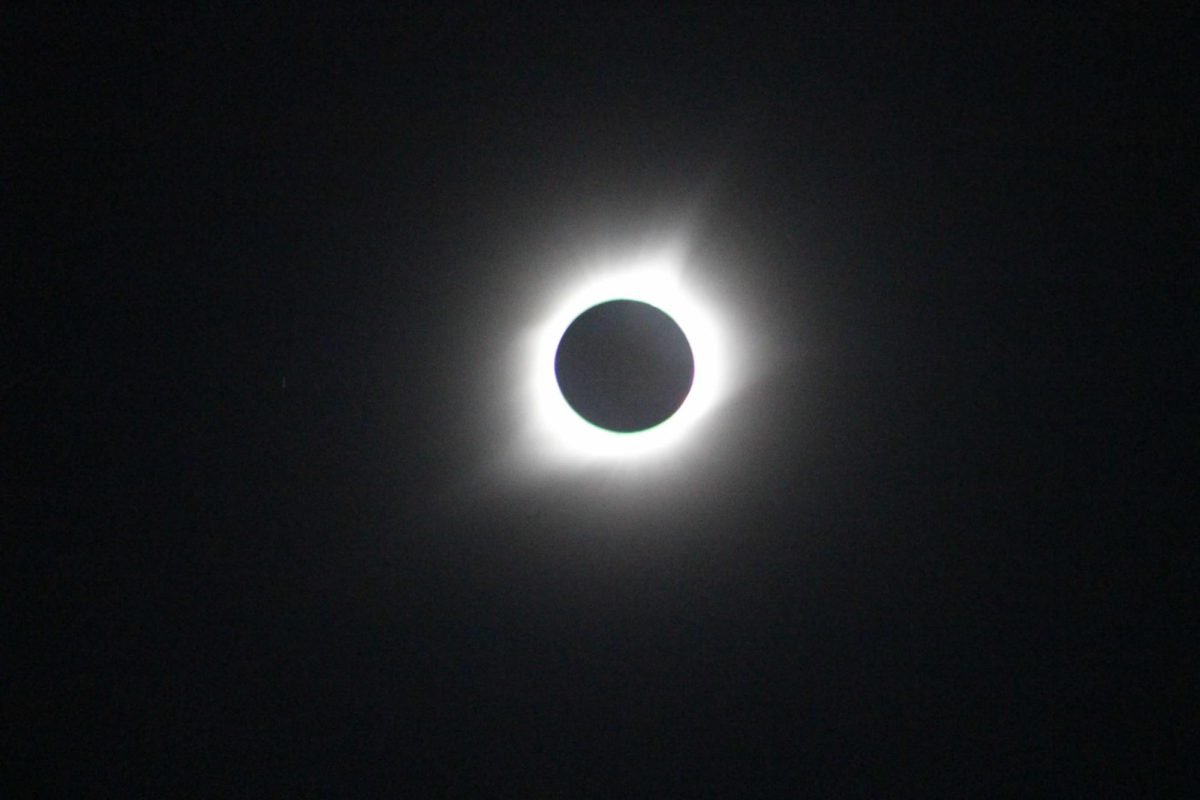On April 8th, 2024, night happens twice in America. The second total solar eclipse visible in the U.S. of the 2000’s will be occurring, an incredibly breathtaking and rare event that will not occur again for another two decades. The last total solar eclipse occurred on August 21st, 2017.
Solar eclipses occur when the Moon passes in between the Sun and the Earth, blocking out light from the Sun. If you find yourself within an area where the eclipse will occur in totality, the sky will darken like dusk in the mid-afternoon. This gives viewers the chance to observe the Sun’s outer atmosphere, called the corona, due to the Moon-brought darkness. The Sun’s corona is usually invisible due to the star’s brightness, making this opportunity for observation all the more valuable.
There are five different stages of a total solar eclipse: Partial Eclipse, Shadow Bands, Baily’s Beads, Diamond Ring, and Totality. The partial eclipse is the longest stage, visible almost everywhere in the United States. Only a portion of the Sun will be covered by the Moon, altering the visible shape of the sun. Partial eclipse will normally last anywhere between 70 to 80 minutes.
As the eclipse approaches and emerges from totality, Shadow Bands–dark, fast moving bands punctuated by white patches–will be visible on the ground, caused by the atmosphere’s light distortion in this period. During the time even closer to totality, a visible phenomenon called Baily’s Beads will occur. Several small blips of light will be able to be seen around the Moon’s outline, caused by light rays shining through the Moon’s many valleys. In the moments just before totality, all but one of these lights will go dark, creating the Diamond Ring effect. A halo of light will begin to appear behind the Moon’s surface, a sign of the eclipse’s proximity to totality.
The most anticipated stage is of course Totality, when the Moon has fully eclipsed the Sun. A bright halo of light around the Moon will be the sky’s only illumination. This halo effect is the combination of two different unique layers of the Sun’s atmosphere. A less easily spotted, pink-tinted outline is the visible chromosphere, a lower region of the Sun’s atmosphere. The Sun’s corona, an outer layer of its atmosphere, will also be visible as huge streams of bright white light. Other visible phenomena during the stage of totality include the possibility of a 360 degree sunset and increased brightness of various stars or planets. The darkness during this period may have other strange effects, such as eerie silence from the wildlife surrounding you or the awakening of nocturnal animals who have been confused by the sudden change in brightness and temperature.
After totality, the Diamond Ring and Baily’s Beads effects will shortly reoccur before the eclipse returns to a partial state.
A partial eclipse will be visible from all 48 continental states, but totality will only be reached in certain states–Maine, New Hampshire, Vermont, New York, Ohio, Indiana, Kentucky, Illinois, Missouri, Arkansas, Oklahoma, Texas, and our home state, Pennsylvania. The closest location to North Allegheny Senior High School that will reach totality is Erie, PA. The partial eclipse will begin in Erie at 1:02 PM EST, with totality beginning at 2:16 PM EST. Erie’s totality will peak at 2:18 PM EST and end at 2:20 PM EST. The visible partial eclipse will end at 3:30 PM EST.
When watching the eclipse anywhere, proper sun-viewing precautions must be taken. It is not safe to observe the eclipse with the naked eye during any stage other than complete totality. Even darker stages like Baily’s Beads and the Diamond Ring effect can cause damage to your sight if observed without the proper precautions. The eclipse should only be viewed through approved solar viewing glasses, which are thousands of times darker than regular sunglasses. Handheld solar viewers are also a safe alternative for direct observation. If you plan to view the eclipse through a camera or telescope, ensure the use of a special-purpose solar filter to avoid extreme eye injury.
If you are watching the eclipse in the nearest totality-range location of Erie, the only time it can be observed without special eye protection is from 2:16 to 2:20 PM EST. If you are not within the range of totality on April 8th, you should never attempt to observe the eclipse without proper eye protection.



